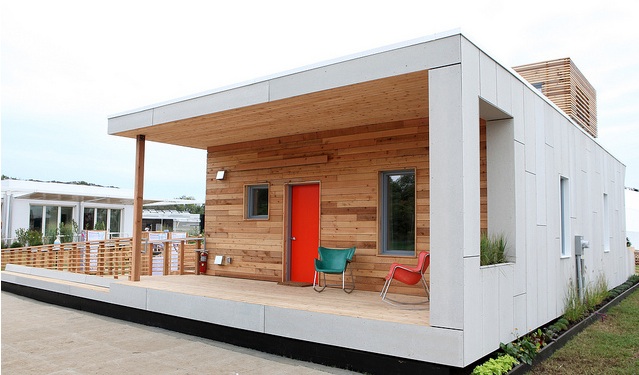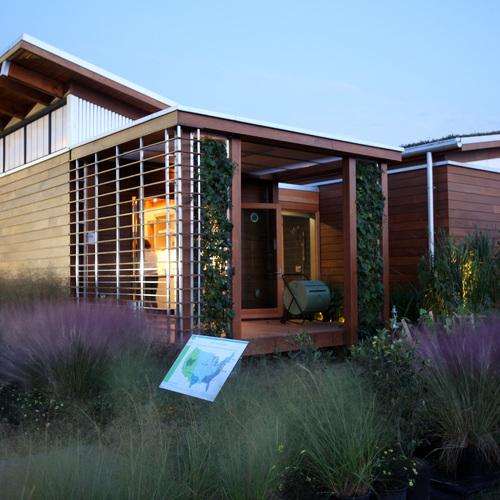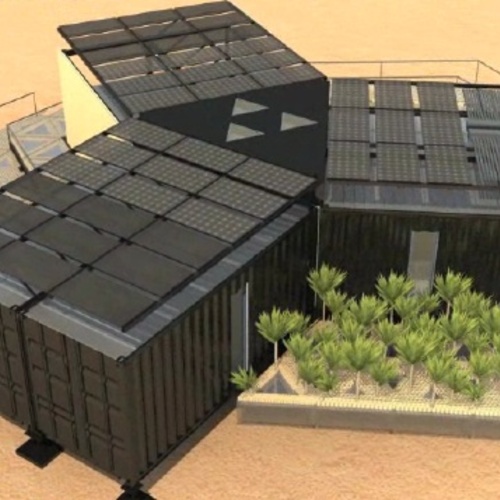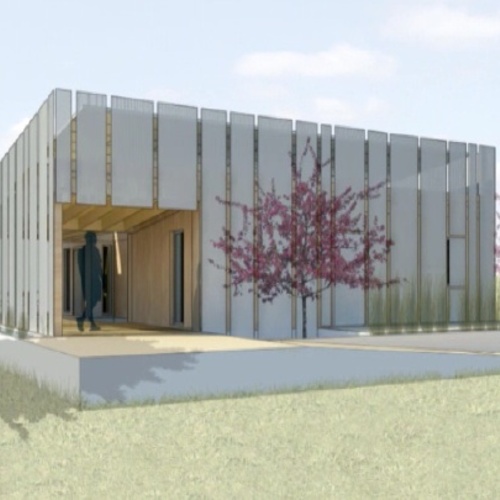Image Credit: Jim Tetro, U.S. Department of Energy Solar Decathlon
Image Credit: Jim Tetro, U.S. Department of Energy Solar Decathlon The WaterShed house from the University of Maryland team took first place in the Solar Decathlon’s architecture contest and third place in the affordability contest. As of midday on September 29, WaterShed was the overall Decathlon leader.
Image Credit: Michelle Kaufmann
The newest of the 2011 Solar Decathlon’s 10 contest categories – affordability – has become an impressive showcase for design ingenuity, and powerful evidence that building energy-efficient homes doesn’t have to bust the bank.
The rules are simple: homes that cost $250,000 or less to build earn the contest category maximum of 100 points, while homes costing more than $250,000 lose points on a sliding scale that tapers to zero at the contest limit of $600,000.
On Tuesday, two Decathlon entries – Parsons The New School of Design and Stevens Institute of Technology’s Empowerhouse and Purdue University’s INhome – took first-place honors with scores of 100 points each.
The low and high ends
The estimated cost of Empowerhouse, which is designed as low-cost housing for Washington, DC’s Deanwood community, is $229,890. INhome, featuring a traditional Midwestern design, landed at $249,596, while the contest’s second-place finisher, Team Belgium’s E-Cube, took 99.885 points based on an estimated cost of $251,147.
In third place, Southern California Institute of Architecture and California Institute of Technology’s CHIP house scored 98.750 points based on an estimated cost of $262,495.
The low score for affordability, 46.593 points, went to University of Tennessee’s Living Light, whose estimated cost is $470,574. At 750 sq. ft., Living Light is, paradoxically, one of the smallest entries in the Decathlon, which set the size limit on interior space at 1,000 sq. ft. But the steel-frame building also features unconventional construction, including layered glazing on its north and south exterior walls: an outside single fixed pane of tempered R-1 glass sits on shock-absorbing mounts; on the inside, R-11.4 triple-pane windows, some of which are operable, sit in wood-veneered aluminum frames. Transparent glass dominates the south façade while translucent glass dominates the north façade, although the operable-window areas on each will be about the same.
A juried category
A Department of Energy press release noted that two jurors spent nine months evaluating each entry to come up with cost estimates and affordability scores: Matt Hansen, founder of Takeoffs Construction Estimating and partner at Licata Hansen Associates Architecture, and architect Ric Licata, a fellow and current western regional director of the American Institute of Architects.
“Purdue’s use of a traditional design and construction approach demonstrated high tech energy and control systems for a sophisticated yet conventional market,” Hansen said of INhouse. “The general public would not perceive it as a solar home.” (Click here for a summary of cost estimates.)
Architecture and home entertainment
While Tennessee may not have been competitive on price, it came in fifth in the architecture contest (another juried category), scoring 92 out of 100 points. The architecture contest winner, University of Maryland’s 920-sq.-ft. WaterShed house, also was, as of 11 a.m. September 29, the overall Decathlon leader. (Click here for a summary of overall standings.)
Of the six contests whose results have been announced so far, WaterShed has managed to place among the top five in all but the home entertainment category, which Middlebury College’s Self-Reliance house won with a score of 80.269 out of 100.
Weekly Newsletter
Get building science and energy efficiency advice, plus special offers, in your inbox.
















5 Comments
the EmpowerHouse (a
the EmpowerHouse (a passivhaus) is the lowest cost project... and achieving passivhaus allowed the project to utilize the smallest PV array in solar decathlon history. nice!
the third place team (ghent! been too long, time to go back!) was also built to be a passivhaus.
not too shabby and congrats to the parsons new school/stevens team as well as team belgium for helping to destroy the 'passivhaus is too expensive' myth!
Nice job, but...
I am pleased to see them getting the costs down on these solar decathlon homes, I am also pleased to see them achieve passive-house-like air infiltration and solar gain and storage abilities. However, out here in the real world, we are beating them by a country mile. Our most recent home is nearly 2,000 square feet, it was constructed without any volunteer labor by a registered general contractor (including contractor mark-up) for less than $230,000 including the 6.7 KW of PV, and with just 3KW more PV (just about $15,000 cost) it would power a Nissan Leaf for more than 8,400 miles per year, in addition to completely powering itself. I think the kids need to up their game!
Congratulations to Purdue, they are on the right track!
Affordability
Maybe someone else can chime in on the target market for these homes. First off most of the Solar Decathalon homes were 1 or 2 bedrooms. Most modern families want 3 bedrooms+. Also for Perdues numbers they were listing lot costs at $37K. On the East Coast I don't see that happening.
As much as I am onboard with the passive house idea unless we can get cost down to a point where you get payback in 7 years (average time an American is in a home) long range investments in solar or energy efficency don't make economic sense. They are just bragging rights for upscale consumers.
Rick
Affordability Reply
Richard, I was the project manager for Purdue's home. The affordability contest judged homes on the builder's cost (labor and materials) and did not include a lot in the cost breakdown. I am not sure where you got the 37K number for the lot. I checked with our construction manager and that was not in the numbers. If you wanted to walk into our house after purchasing a lot and paying all the closing fees, then a person would pay around $1200 a month on a 30 yr mortgage if the house was placed in Lafayette, IN (near Purdue's campus). As for the number of bedrooms, I agree that most families do want more than 1 or 2 bedrooms, but we were enforced by rules to stay under 1,000 sf.
I agree that in most cases that solar still is a tough sell for the average homeowner, but that is quickly changing. Even during the 2 years that we worked on the Purdue dome, PV noticeably declined in cost. I like to tell people that even if you don't want to install PV yet, you can be net-zero ready. When you decide that PV is cheap enough, then at that point you can have them installed. During the time without PV, you still reaped the benefits of having an extremely well performing home. Thanks for all of the great comments.
Nice job, but.... reply
Ted,
Thanks for the nice comments about Purdue's house. Great work with your home! We tried very hard to stay around the $250,000 budget. Some of the items that were judged as part of the competition and things we had to add for to make it to competition added cost to the budget. First, labor was included in the cost and did not represent and volunteer labor. If it was something custom that would require more labor than normal, then that was added as well. Our PV system was about 8.7 kW to make net-zero in Indiana and was oversized by about 20% to make sure we were net zero during the competition. It is a little tricky because instead of looking at the entire year, we have to prove ourselves in 10 days. It rained about 7 of those days, but we still managed to be net positive. Also, there was some cost associated with beefing up the structure to make the home transportable and the crane we used to set the house on the competition site was added. Also, all the appliances, electronics, and window treatments were added into the 250 number. Like I mentioned to Richard, we were required to stay under 1000 sf for the competition. Our house could have easily been scaled larger without too much of a cost increase. Another bedroom or 2 could have easily been added on. In fact, during our initial design, we played around with different configurations to make it larger to demonstrate that ability. The HVAC system in the home can modulate and is large enough to handle the extra space, and no plumbing would have to be added.
That being said, the competition has evolved over the years to try to make the homes more realistic. The budget is a perfect example. The 2009 home that won was 800 sf and was over $1 million. The 2011 winner was 350k and our house was 255k. I think in next competitions, the budget should be lowered from 250 or more points should be deducted compared to the 2011 competition. Thanks for the comments.
- Kevin
Log in or create an account to post a comment.
Sign up Log in